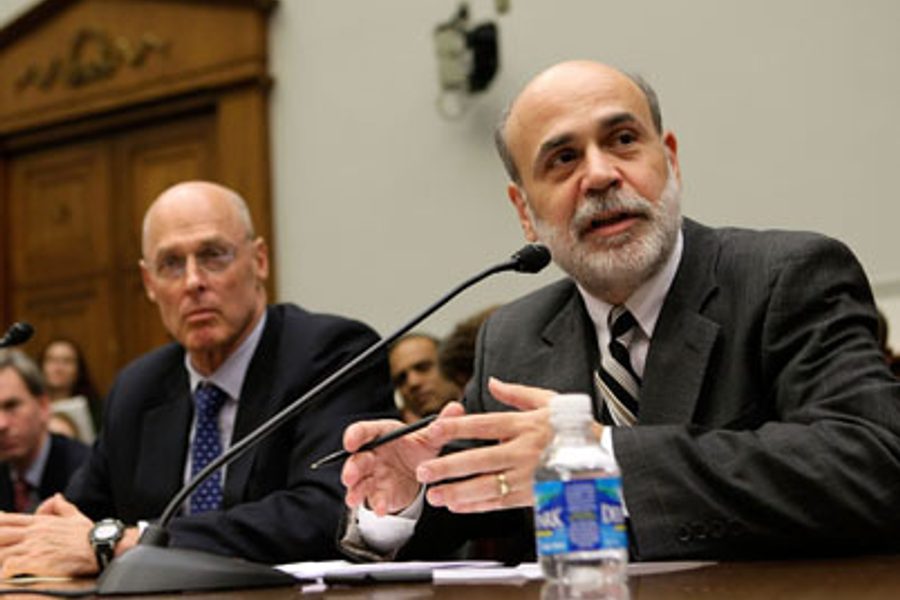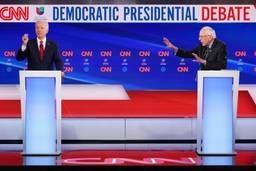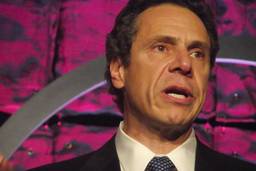Turning a Wall Street Giveaway Into a Rescue for All Americans
Charting a progressive response to the crisis
David Sirota

[Editor’s note: The following article provides a summary of the complex issues involved in negotiations over how to respond to the credit market crisis. For the sake of simplicity and navigability, it is broken into five separate parts, which you can scroll to individually: 1) The State of Play 2) Leadership Moves 3) Alternatives 4) Likely Outcomes and 5) The Progressive Bottom Line.]
Following the astounding rejection of Henry Paulson’s speculator bailout plan in the U.S. House of Representatives on Monday, a wave of doomsday propaganda from Washington, both presidential candidates and the media has flooded the airwaves – all aimed at trying to force public opinion to support handing over $700 billion to Wall Street, no strings attached. But as the Washington Post poll today shows, the public isn’t budging. Indeed, after 16 years of aggressive deregulation from both the Clinton and Bush administrations, the country has figured out that when the Establishment in unison backs something for Wall Street, it means taxpayers are about to get fleeced.
With the Dow shooting up and down across the nation’s television screens, Americans are worried about their jobs, pensions and savings. They are also confused about what their government is going to do. And so as Congress prepares to reconvene on Wednesday, here’s the state of play, the likely outcomes, and what progressives must demand.
STATE OF PLAY: LOBBYISTS CIRCLING FOR THE KILL
In two separate stories, The Politico reports that Corporate America is intensifying its efforts to ram the Paulson plan through Congress, despite the House’s stunning rebuke. Specifically, the U.S. Chamber of Commerce – the most powerful corporate front group in the country – is overtly threatening retribution against any lawmaker that opposes the $700 billion bailout. Meanwhile, the lobbying industry is reaping a windfall from industry clients expecting to profit off the Paulson plan.
Though House Democrats spent Monday claiming that the original Paulson plan was amended to include stronger protections for taxpayers (CEO pay limits, aid for homeowners, equity stakes in financial houses for taxpayers, etc.), the Treasury Department was simultaneously holding a secret conference call with Wall Street analysts explaining how those new provisions were specifically written to be unenforceable (you can listen to the conference call here).
The conflicts and corruption surrounding the bailout have even impacted internal Democratic Party deliberations. At an afternoon press conference (video here), Rep. Peter DeFazio (D-Ore.) recounted how when progressives and Blue Dog Democrats proposed a financial industry tax to pay for the bailout, Democratic leaders sent in Laura Tyson to kill it by saying “the street wouldn’t like it.” According to DeFazio, Tyson was brought in “under the guise of being a former Clinton economic adviser, forgetting to tell us she’s on Morgan Stanley’s board of directors.” Despite her corporate ties (or perhaps because of them), Tyson is also simultaneously an adviser to Barack Obama’s presidential campaign.
LEADERSHIP MOVES: A GOP STRATEGY OR A DEMOCRATIC STRATEGY?
Much of the legislative wrangling is going to play out in the House, rather than the Senate. Unlike the upper chamber’s members, every lawmaker in the lower chamber is up for re-election and therefore the fear of voter backlash is a more prohibitive factor in supporting this bailout in the House than in the Senate. That said, the Associated Press reports that the Senate is trying to attach a Republican-backed corporate tax cut to the bailout – one that the House has already rejected. If that passes, it could potentially create an insurmountable legislative gridlock between the chambers.
As I noted in my report yesterday, the question for the House Democratic leadership is whether to make the proposal that got rejected on Monday more conservative or more progressive.
If Democratic leaders make the bill more conservative – for instance, by loading it up with corporate tax cuts, as the GOP demands – it could eke through the House with almost all GOP support. Of course, this would be an unprecedented move, in that the House Democratic leadership would be using its power to steamroll its entire party and hand over the reins of legislative power to the minority party.
Alternately, the Democratic leadership could add in key Democratic priorities, such as toughened financial regulations, bankruptcy law reforms helping homeowners prevent foreclosure, direct government aid to mortgagees, a tax on the financial industry to pay for the bailout, and the job-creating $60 billion economic stimulus/infrastructure spending package the House passed a few days ago. This would sacrifice Republican votes for the Paulson plan, but it could unify the Democratic majority to pass the bill with mostly Democratic votes.
To date, it looks like House Democratic leaders are leaning to the former, rather than the latter. Rep. Joe Crowley (D-N.Y.), one of the Democrats’ top recipients of corporate cash, told Roll Call that the focus is on convincing 12 more Republicans to support the bill – rather than getting more Democrats to support it. ABC’s George Stephanopoulos says it is “unlikely” that the Democratic leadership will move to “get more Democrats on board” and instead will probably tilt right to get more Republican support.
At the same time, the media commentariat pushing the bill is clamoring for immediate action and no substantive changes at all. Their assumption: The public is drop-dead stupid. Bloomberg News’ Al Hunt, for instance, told PBS’s Charlie Rose that Democrats should add in meaningless “cosmetic” changes to give lawmakers cover to switch their votes – as if those lawmakers wouldn’t face scathing criticism from their re-election opponents at home. Likewise, the New York Times’ David Brooks claims “there’s no time to find a brand-new package.” But that is far from true.
ALTERNATIVES: PROGRESSIVES MOVE TO STRENGTHEN THE LEFT-RIGHT COALITION
Seeking to strengthen the Left-Right coalition of Democrats and Republicans who defeated the Paulson bailout on Monday, progressives introduced a bailout alternative at a Capitol Hill press conference on Tuesday afternoon. They outlined the No BAILOUT Act, which would strengthen financial industry regulation of short selling and other speculative gamesmanship through the Securities and Exchange Commission, change accounting rules to let banks show more assets, and empower the FDIC to open up banks’ books, restructure bank management, and provide short-term liquidity to the credit markets – with no automatic outlay of taxpayer cash. The bill already has the support of the Service Employees International Union, and the political strategy behind the initiative is shrewd: It aims to solidify all of the Democratic and Republican “no” votes against any bill still structured like Paulson’s $700 billion giveaway, and includes admirably progressive themes.
In terms of details, the upside of the alternative plan is two-fold: It introduces the concept of re-regulation into the bailout debate, and it proposes a more measured and prudent way of providing taxpayer support to the financial sector.
The plan is modeled off concepts outlined in the Washington Post by both former FDIC Chairman William Isaac and University of Texas economist James Galbraith and conceptually supported by some House Republicans because it costs no taxpayer money up front.
According to a bill summary, the legislation would require the FDIC to survey the banking industry and issue short-term loans (through an exchange of “net worth certificates” and bank promissory notes) to those banks that qualify. In exchange for the short-term infusion of capital, banks would “be subject to strict oversight by the FDIC including oversight of top executive compensation and if necessary the removal of poor management.” As Isaac noted, this exact program was enacted by Congress during the S&L scandal of the 1980s and helped “resolve a $100 billion insolvency in the savings banks for a total cost of less than $2 billion.”
The questionable part of the plan deals with the accounting rules.
Right now, federal law mandates that banks assess their assets on a “mark-to-market” basis – that is, what their assets could be sold for right now, rather than what they could be sold for in the future. The theory is that during a housing and financial crisis, the “mark to market” value of mortgages is artificially low, even though those mortgages represent houses with actual value (for instance, because no one wants to buy mortgages right now, many mortgages are valued at zero on a mark-to-market basis, even though they represent homes that could ultimately be sold for value). Because what a bank can lend out is a multiple of the assets they own, proponents of the accounting change argue that the mark-to-market system is forcing banks to devalue their assets and therefore contract credit. They say that changing the accounting rule to allow banks to list their assets at an “economic value standard” (ie. higher than mark-to-market) will therefore loosen up credit.
The problem with this accounting change is that it would allow banks to leverage even more against assets whose value is still unknown. That, says some opponents, could simply push off – and potentially make more intense – an inevitable day of collapse in the banking system.
LIKELY OUTCOMES: FOUR POSSIBLE PATHS
Yesterday morning, Barack Obama and John McCain both reiterated their support for the Paulson bailout plan, but also called for a wide expansion of the FDIC’s authority to guarantee bank deposits. The Wall Street Journal now reports that House leaders are considering a re-vote on the plan that was rejected on Monday, only with this expanded FDIC authority tacked on. For lawmakers who will be asked to switch their vote, that change – though positive – seems like thin gruel to justify such a monumental reversal to constituents back home.
With all this in mind, there appears to be one of four likely outcomes:
1. Congress Does Nothing: Under this scenario, House leaders bring the bill back for another vote, perhaps with the FDIC expansion on it, and the “no” votes do not switch, either because the changes aren’t enough, or because they support the No BAILOUT Act instead. Though the media has billed this outcome as Armageddon, many economists think this is a better solution than simply dumping $700 billion of taxpayer cash on Wall Street. Ultimately, the Treasury Department and the Federal Reserve would be able to use its authority to nationalize banks and restructure them, much like Sweden successfully did in the early 1990s.
2. Congress Passes the No BAILOUT Act With Bipartisan Support: If House leaders agree to allow a vote on the progressives’ alternative (a big “if”), it could pass with the same coalition of Republicans and Democrats that voted “no” on the Paulson plan.
3. Congress Passes the Paulson Plan With Bipartisan Support: Depending on the strength of the corporate lobbying campaign, House leaders could re-vote on the Paulson plan and change 12 votes. This, however, would require 12 lawmakers to switch their votes on the most monumental and high-profile economic legislation in a half century – likely meaning electoral retribution at home.
4. Congress Passes A Progressive Bill With All Democrats: There remains a chance that House Democratic leaders will restructure the Paulson plan to give the Treasury Secretary far less money and authority to address the credit markets’ liquidity problem, and also tack on key progressive priorities including bankruptcy law reforms, aid to homeowners, economic stimulus (infrastructure spending, etc.), financial regulations and a financial industry tax to pay for any losses to taxpayers. As historian Rick Perlstein notes, this is exactly the kind of strategy Franklin Roosevelt employed in the face of the Great Depression. He used the crisis as the rationale and vehicle for true progressive reform.
THE BOTTOM LINE: WHAT PROGRESSIVES MUST DO
The initial defeat of the Paulson plan on Monday – which was brought about with major grassroots/blogospheric pressure but little progressive institutional support – provides the progressive movement a unique and historic opportunity of converging factors it may never have again: A Republican president desperate for a Democratic Congress to pass a massive spending bill whose stated objective is to save the economy; a public that strongly supports tougher financial regulations and social spending, and opposes taxpayer bailouts to billionaires; an imminent election making legislators fear voting against their constituents; and a legislative body that has shown it feels so much popular pressure it is now willing to defy the moneyed Establishments of both parties. For progressives, this means four things:
1. Press for the New Deal, or at Least the FDIC Plan: Out of the likely legislative outcomes, progressives should be demanding that House leaders say what Rep. Donna Edwards (D-Md.) said at a press conference on Tuesday (video here): “It’s a clean slate and its our job for our constituents and for the country for us to say there’s another way.” That means throwing out Paulson’s plan, going back to the drawing board, and constructing a plan that creates a Reconstruction Finance Corporation-type agency to buy some bad loans; nationalizes and restructures failing banks; invests heavily in job-creating infrastructure programs; provides direct aid to homeowners; includes new regulations for Wall Street (i.e., banning short-selling shenanigans, reinstating and updating the Glass-Steagall Act, etc.); reforms bankruptcy laws to help homeowners renegotiate their loans; expands the FDIC’s scope and authority; and pays for any taxpayer losses with a tax on the financial industry. Short of this, we should support the effort by House progressives to use the No BAILOUT Act to forge a Left-Right congressional coalition around a bill that at least strengthens the FDIC and protects taxpayers.
2. Demand the House Leadership Allow A Vote on An Alternative: At this moment, the House Democratic leadership has not indicated whether it will even allow a vote on an alternative to the Paulson plan. At minimum, progressives must demand a vote on an alternative.
3. Strongly Oppose the Paulson Bailout…Or Anything Worse: With so many award-winning economists and experts saying Paulson’s $700 billion, no-strings-attached plan could actually worsen our economic problems, and with Obama acknowledging that this giveaway will hamstring his potential administration’s agenda, progressives must continue their “Hell No!” campaign against the White House proposal, should the Democratic leadership continue pushing it (and especially if Senate Democrats actually make the Pauslon plan worse by attaching a corporate tax cut to it). Wild-eyed cries to “do something!” have been the major arguments for the Paulson plan - and such substance-free hysterics are not even close to convincing or substantive rationales for spending 5 percent of our entire nation’s economy on such a poorly conceived and potentially destructive plan - especially considering that plan gives most of the power to the same kind of Wall Street tycoon who helped engineer this situation.
4. Insist Progressive Groups Get Off the Sidelines: To date, many major progressive institutions have done nothing to shape or advance this debate, despite it being the most important economic deliberation in at least a generation. For instance, most major labor unions - though not all - have only tepidly opposed the Wall Street bailout. Though groups like TrueMajority and the Working Families Party are working hard to mobilize bipartisan grassroots opposition, other groups like Moveon.org are opportunistically using the debate to simply bash John McCain, despite the fact that both McCain and Obama support the Wall Street giveaway and despite the fact that such politicization could destroy whatever productive Left-Right coalition can be built in opposition. Such behavior is motivated by institutional leaders who prioritize their partisan affiliations and relationships over their organizations’ stated goals of advocating a progressive agenda, regardless of party. These leaders don’t want to get crosswise with a Democratic Party establishment and a Democratic Party presidential candidate swimming in Wall Street cash and thus supporting this bailout. But the time for that kind of partisan pandering and power worshiping by progressive groups is over. It’s time for them to get engaged in a real, hard-hitting way.
The next few days will answer the most fundamental questions we face as a country. After dishonest fear mongering misled us into a war in Iraq, are we finally “shock resistant,” as Naomi Klein says? Can we force our Congress to represent the wishes of the vast majority of the public? Or is the political, media and financial propaganda system simply too powerful to prevent an economic crisis from being used as a rationale to reward those who created the crisis? As the House’s stunning vote on Monday showed, We the People still have a bit of a say in our democracy. Now it’s time to make sure what We the People wants is what we end up getting.
David Sirota is an award-winning investigative journalist and an In These Times senior editor. He served as speechwriter for Bernie Sanders’ 2020 campaign. Follow him on Twitter @davidsirota.








